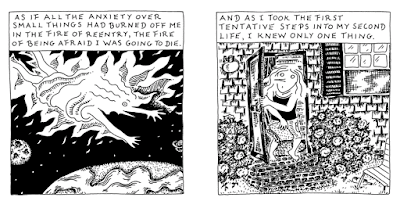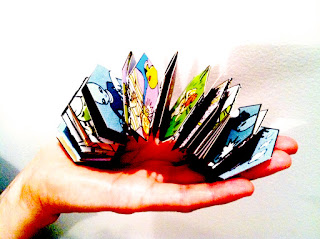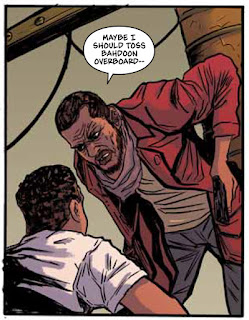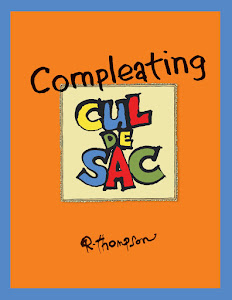
by Mike Rhode
A few years back I was doing an academic talk and paper which eventually was published as
Graphic Tales of Cancer. Jennifer Hayden was working on her own story about cancer and was kind enough to talk with me then about her cartooning project about cancer. It's finally out now and I couldn't be more pleased to present this Q&Q with her. Everyone should go to the Small Press Expo this week, and buy her book.
Why will you be in Washington?
I'll be in Washington as a guest of Small Press Expo (SPX), where I'll be debuting my new graphic novel
The Story of My Tits.
What type of comic work or cartooning do you do?
I write and draw autobiographical comix. My new book is a 352-page graphic memoir about my life and my experience with breast cancer. My first book Underwire (published in 2011) was a collection of short-storylength comix about my family. I post a short-form four-panel webcomic
called S'Crapbook at activatecomix.com and a webcomic diary called Rushes at
thegoddessrushes.blogspot.comthegoddessrushes.blogspot.com, part of which I self-published in 2013.
How do you do it?
With my diary comic, I draw with a copic pen in a blank Clairefontaine notebook. With all my other comics, I draw on Bristol paper with a rapidograph, which has begun to hurt my hand, so I do some details with a dip pen. I now also add tones with a black watercolor pencil, which I wet for a softer, painted look. I work panel by panel, not page by page, and go straight to ink, no pencil. If I don't like the panel, I toss it out and start over. I write in a notebook at my side, where I test the words until I get them right before I start the panel. I never really know what's next--I like the surprise. When the art is done, I scan it and assemble the pages in Photoshop, cleaning things up, but always keeping the hand-drawn look.
When (within a decade is fine) and where were you born?
Oh, it's time for me to be classy about my age. I was born in 1961 in New York City.
 Can you tell us a little about your new book that you'll be in town discussing?
The Story of My Tits
Can you tell us a little about your new book that you'll be in town discussing?
The Story of My Tits is a graphic memoir about my bout with breast cancer, but it includes a lot of other stories that ripple out from mine and resonate with it, like my mother-in-law's cancer story, my mother's cancer story, the story of how these marriages were affected by cancer, and how my own childhood, teenagehood, adulthood, marriage and motherhood influenced the way I reacted. I have to add that I think of it as a graphic novel, not a memoir, because I was less interested in being accurate and more interested in giving the reader the same ride through life that I had had, which involved some tragicomic tweaking here and there.
Breast cancer is a serious illness much discussed in the media, but it's also very personal. How did you decide to do a comic on it? Where did the amusing, but perhaps off-putting book title come from?
Cancer has been a popular subject for graphic novels, it seems to me. It's the perfect medium for this disease, because you can be almost simultaneously hilarious and desperately sad. And ironic, and informative, and real, and anything else you want. Comix are so utterly free. From the moment I was recovering from my breast cancer experience--which was when I discovered graphic novels--I knew this would be the best way for me to tell my story. I was very inspired by Marisa Marchetto's great strip
Cancer Vixen in
Glamour magazine, which I saw before she turned it into a book, and that helped convinced me this was the way to go.
I don't remember really considering any other title. When I wrote it down I thought, uh-oh. This isn't going to be one hundred percent popular. But then again, I'm not writing this book to tell anything but the truth. So that's the title and I stuck with it. And my publisher Top Shelf never asked me to change it.
What is your training and/or education in cartooning?
I have none. I studied a lot of literature in high school and college, where I majored in art history, so I also studied a lot of great art and loved learning how visual narratives were built into those images. I always drew, and read
Archies compulsively when I was growing up, but I lost track of comics as a grownup. Then, having written a few (very bad) novels that were never published (thank the Goddess) and illustrated some children's books (which were just too rated G for me), I stumbled on
graphic novels and I just felt like I had come home. I knew exactly what to do. I gave myself a year to read all the best graphic novels I could find, then made myself sit down and start.
The Story of My Tits begins with the first comix panel I ever drew.
Who are your influences?
Oh, so many. Fred Astaire, Lucille Ball, Charles Dickens, Albrecht Durer, Maurice Sendak, Hilary Knight, Goscinny and Uderzo (Asterix and Obelix are the gold standard for me; the most comedy and emotion in comics per square inch!), Garry Trudeau, Alison Bechdel, Lynda Barry, Julie Doucet, Dame Darcy, Will Eisner, and Jeffrey Brown. For a start.
If you could, what in your career would you do-over or change?
Discover comix in college, before I started losing my eyesight and getting sore hands. Go to art school and get some training in other media. But I probably would have just ruined art for myself, since I ruined everything then, being so hell-bent on "being an artist" (actually, at that time, a writer) and not on living a life that would inspire me to make art. So, I guess, actually, I would change nothing. It was all supposed to turn out this way.
 What work are you best-known for?
What work are you best-known for?
Best-known for!? Possibly my pioneering work in conversational swearing. I'm not sure I'm known at all!!
Underwire was my first webcomic and my first book, so if I'm known for anything, it would have to be that.
What work are you most proud of?
Well, I really have done great work advancing the art of conversational swearing. But I'm also very proud of
The Story of My Tits. All the years I was writing, all the years I was drawing, I was trying to grasp life, hold it for a moment, trap it, get it down where someone else could see it and feel it, just like me. And I think that in this book maybe at last I have.
 What would you like to do or work on in the future?
What would you like to do or work on in the future?
I have two more autobio projects I'd like to see in print--my diary comic and a collection of my S'Crapbook strips--but then I feel like getting my feet wet in fiction again. I have another graphic novel in mind that's a mix of family history, autobiography, and fiction. I've taken notes on index cards for a while and thrown them in a box, so I'd like to open that box and see what happens.
What do you do when you're in a rut or have writer's block?
I do not say those last two words. Ever. I had troubles as a writer I have never had as a comix creator, so I make it a point now just to keep moving forward. And never to judge my subject matter. The greatest skill I have learned is how to recognize that particular tickle of humor/sorrow/ aliveness that makes me know I have a story to tell. I go where it takes me and I do not question it. When I'm in a rut or too swamped with emotion about the subject to go on, I take a break. Hours, days, weeks. I adhere to no schedule, thanks to my publisher. I work every day, but I am the mistress of my own material.
What do you think will be the future of your field?
Many more people are reading graphic novels now, especially women, than two, five, ten years ago. I believe this is a very wide-open art form right now, and it's appealing to some great verbal and visual talents. What you can do in great art and in great literature, you can do in graphic novels, only it's better, because you can use techniques from both at the same time. I think we're going to see some incredible masterpieces, which will establish the graphic novel, like jazz or rock 'n roll, as a vital new channel of expression.
 You've attended the Small Press Expo previously - do you have any thoughts about your experience? Will you be attending it in the future?
You've attended the Small Press Expo previously - do you have any thoughts about your experience? Will you be attending it in the future?
Oh, I absolutely love Small Press Expo! This is my sixth year, and it is the highlight of my comix calendar. The organizers are fantastic, the venue is relaxed, the exhibitors are nothing but the best. I've exhibited there, I debuted my first book
Underwire there in 2011, and I never miss it. Last
year I got a chance to tell Jules Feiffer--a guest of the show--how much I adored his book Kill My Mother--and in the next moment I met a brand-new cartoonist visiting from Switzerland and had lunch with her at the bar, talking about autobiographical comix. Everyone is there for the love of
the art form, and it just seems to erase all barriers.
What's your favorite thing about DC?
I grew up in New York City, so what I love about DC is that it's such a small city, and yet there's so much in it. It also feels European to me, with all those big pretty streets and monumental, classical buildings. When I first went to the Smithsonian, I was just running along the mall, in and out of all those unbelievable museums, cackling at my husband: "It's free! It's all free!"
Least favorite?
It does seem to be a company town. Everyone seems to be either working for the government or probably a spy.
What monument or museum do like to or wish to visit when you're in town?
Our family favorite is the Spy Museum. Yeah, we like spies. But I also love the Lincoln Memorial. And all the art galleries, I couldn't even pick one.
Do you have a website or blog?
My website is
jenniferhayden.com and my blog is
goddesscomix.blogspot.com. I have another blog where I post my daily diary comic called
thegoddessrushes.blogspot.com. And if you're on Facebook, my author page is jenniferhaydenauthor.

 What work are you most proud of?
What work are you most proud of?

































